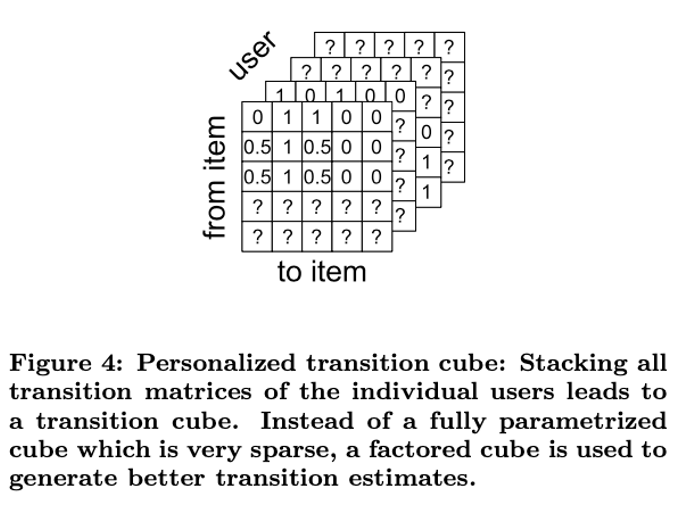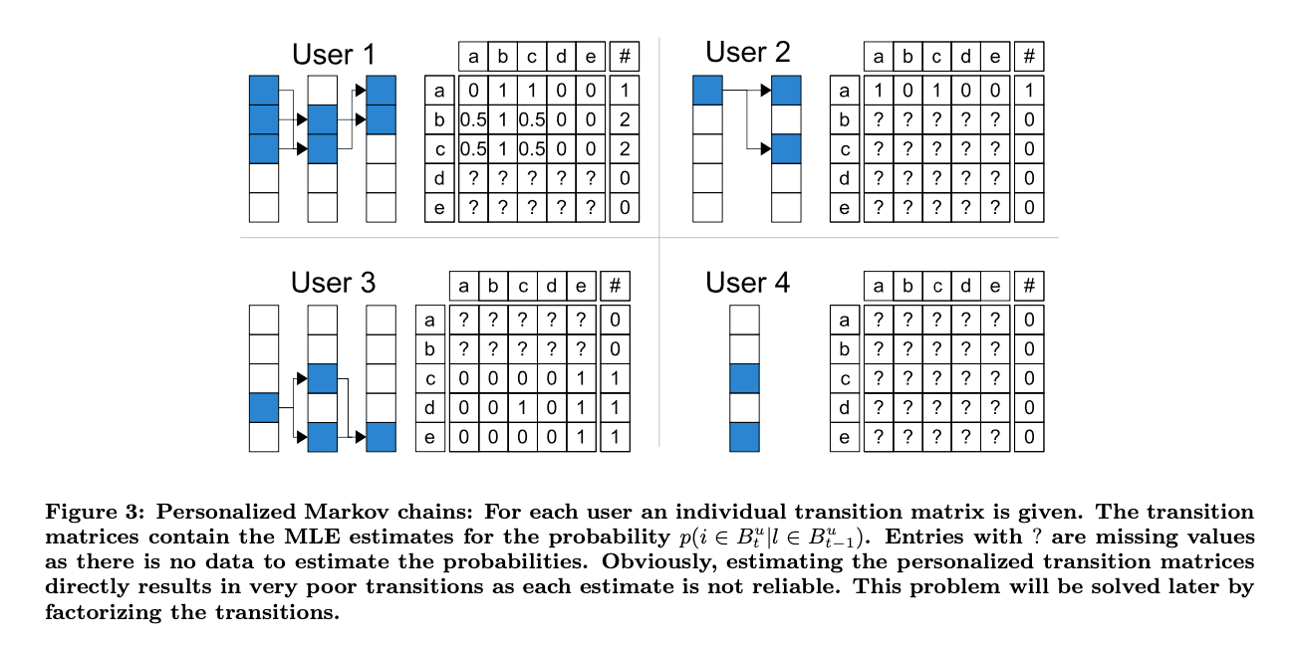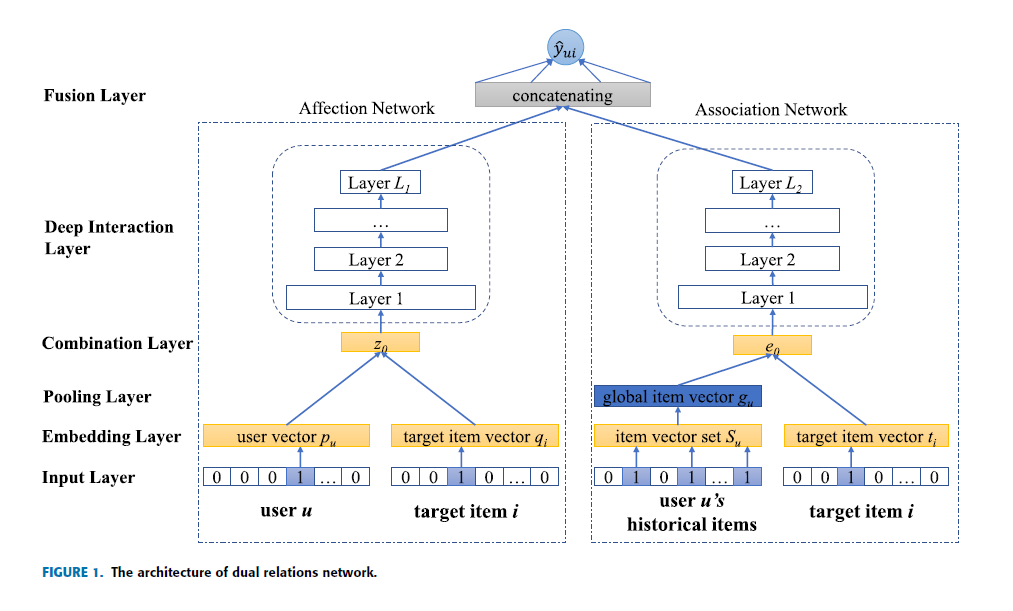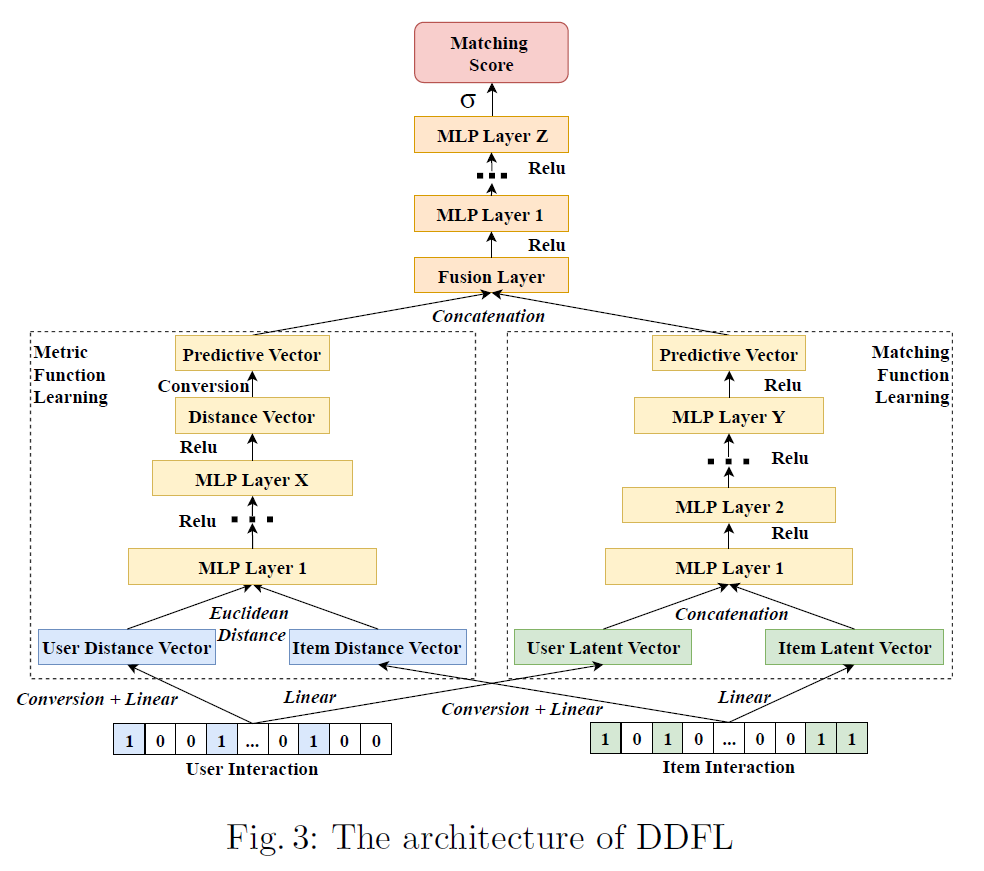MLP based Latent Factor Models
Based on the following lectures
(1) “Recommendation System Design (2024-1)” by Prof. Ha Myung Park, Dept. of Artificial Intelligence. College of SW, Kookmin Univ.
(2) "Recommender System (2024-2)" by Prof. Hyun Sil Moon, Dept. of Data Science, The Grad. School, Kookmin Univ.
Summarize Embedding Method
| Type | How to | Pos | Neg |
|---|---|---|---|
| ID Embedding | 사용자, 아이템 ID 임베딩을 통해 벡터 생성 | 사용자, 아이템의 고유한 특징 포착 가능 | 맥락 정보 부재로 인해 최적화 어려움 |
| History Embedding | 상호작용 이력을 기반으로 벡터 생성 | 사용자 행동 패턴, 아이템 구매 패턴 포착 가능 | 상호작용에 지나치게 의존하여 고유한 특징 포착 어려움 |
| Dual Embedding | ID Embedding 과 History Embedding 결합 | - | - |
| Semi-Dual Embedding | 사용자, 아이템 중 한 측면에만 History Embedding 추가 | - | - |
| Distance Embedding | ID Embedding 시 삼각 부등식을 만족하도록 거리 학습 | - | - |
ID Embedding Method: NCF
-
Matrix Factorization based Latent Factor Model : 내적(Dot Product) 을 활용하는 단순 선형 접근법은 사용자와 아이템 간 상호작용 및 각각의 잠재 표현을 충분히 학습할 수 없음
-
NeuMF : 선형성을 학습하는 행렬 분해 기반 모형과 비선형성을 학습하는 신경망 알고리즘 기반 모형을 결합함으로써 선형성과 비선형성을 모두 포착함
How to Modeling
-
GMF(
\[\begin{aligned} \mathbf{Y}_{\text{GMF}} &= \mathbf{P}_{\text{GMF}} \odot \mathbf{Q}_{\text{GMF}} \end{aligned}\]GeneralizedMatrixFactorization) : 아다마르 곱(Element-wise Product)을 활용하여 사용자와 아이템 간 선형 상호작용 및 각각의 일반화된 잠재 표현 학습 -
MLP(
\[\begin{aligned} \mathbf{Y}_{\text{MLP}} &= \text{MLP}\left[\mathbf{P}_{\text{MLP}} \oplus \mathbf{Q}_{\text{MLP}}\right] \end{aligned}\]Multi-LayerPerceptron) : 벡터 결합(Vector Concatenation)과 신경망 알고리즘(Neural Network Algorithm)을 활용하여 사용자와 아이템 간 비선형 상호작용 및 각각의 복잡한 잠재 표현 학습 -
NeuMF : 선형성과 비선형성을 결합하여 최종 예측값을 도출함
\[\begin{aligned} \mathbf{Y} &= \sigma\left[\mathbf{Y}_{\text{MLP}} \oplus \mathbf{Y}_{\text{MLP}}\right] \end{aligned}\]
History Embedding Method: DeepCF
- Representation Learning based Collaborative Filtering : 사용자와 아이템을 공통의 잠재 공간에 사상하여 내적(Dot Product) 을 통해 유사도를 측정함
- 내적은 선형성을 가정하므로 상호작용의 비선형성을 학습할 수 없음
- 내적은 잠재요인 차원 간 독립성을 가정하므로 차원 간 상호작용을 학습할 수 없음
- 내적은 모든 차원의 비중을 동일하게 취급하므로 차원 간 중요도에 차등을 둘 수 없음
- Matching Function Learning based Collaborative Filtering : 벡터 결합(Vector Concatenation)과 신경망 알고리즘(Neural Network Algorithm) 을 통해 사용자와 아이템 쌍의 복잡한 매칭 함수를 학습함
- 사용자와 아이템 간 단순 선형 유사성이나 각각의 주요 패턴을 포착하여 일반화된 표현을 학습하기에 어려움
- 파라미터 수가 기하급수적으로 증가하므로 데이터 희박성에 따른 차원의 저주 발생
- DeepCF(
DeepCollaborativeFiltering) : 표현 학습과 매칭 함수 학습을 결합함으로써 저랭크 표현 학습 효율성을 달성하는 동시에 사용자와 아이템 간 상호작용에 대한 풍부한 표현력을 확보함
How to Modeling
-
Representation Learning : Dimension Reduction
\[\begin{aligned} \mathbf{Y}_{\text{RL}} &= \text{MLP}_{\text{ReLU}}\left[\mathbf{R}\right] \odot \text{MLP}_{\text{ReLU}}\left[\mathbf{R}^{T}\right] \end{aligned}\]- \(\mathbf{R} \in \mathbb{R}^{M \times N}\) : User-Item Interaction Matrix
- \(\mathbf{P}_{\text{RL}}=\text{MLP}_{\text{ReLU}}\left(\mathbf{R}\right) \in \mathbb{R}^{M \times K}\) : User-Latent Factor Matrix of Representation Learning
- \(\mathbf{Q}_{\text{RL}}=\text{MLP}_{\text{ReLU}}\left(\mathbf{R}^{T}\right) \in \mathbb{R}^{N \times K}\) : Item-Latent Factor Matrix of Representation Learning
- \(\mathbf{Y}_{\text{RL}} \in \mathbb{R}^{(M \times N) \times K}\) : Predictive Vector of Representation Learning
-
Matching Function Learning : Linear Transformation
\[\begin{aligned} \mathbf{Y}_{\text{ML}} &= \text{MLP}_{\text{ReLU}}\left[\mathbf{P}_{\text{ML}} \oplus \mathbf{Q}_{\text{ML}}\right] \end{aligned}\]- \(\mathbf{P}_{\text{ML}} = \mathbf{W}^{(P)} \cdot \mathbf{R} \in \mathbb{R}^{M \times K}\) : User-Latent Factor Matrix of Matching Function Learning
- \(\mathbf{Q}_{\text{ML}} = \mathbf{W}^{(Q)} \cdot \mathbf{R}^{T} \in \mathbb{R}^{N \times K}\) : Item-Latent Factor Matrix of Matching Function Learning
- \(\mathbf{Y}_{\text{RL}} \in \mathbb{R}^{(M \times N) \times K}\) : Predictive Vector of Matching Function Learning
-
Fusion
\[\begin{aligned} \mathbf{Y} &= \sigma\left[\mathbf{Y}_{\text{RL}} \oplus \mathbf{Y}_{\text{ML}}\right] \end{aligned}\]
Dual Embedding Method: DNCF
- DELF(
Dual-Embedding basedLatentFactor Model)- ID Embedding : 사용자, 아이템의 ID만을 활용하므로 사용자 행동 패턴이나 아이템 구매 패턴을 유추할 만한 맥락 정보가 부족함
- History Embedding : 사용자와 아이템의 고유한 정체성, 예컨대 사용자의 독립적인 선호나 아이템의 독립적 특성보다는 과거 어떤 아이템, 사용자와 상호작용했는지에 지나치게 의존함
- 이중 임베딩(Dual-Embedding)을 결합하지 않고 독립적으로 학습하여 최종 표현을 생성하므로 각각의 한계점을 서로 보완하는 표현력을 기대하기 어려움
- DNCF(
Dual-embedding basedNeuralCollaborativeFiltering) : 이중 임베딩을 사용하되, 두 임베딩을 결합하여 학습함으로써 사용자, 아이템 표현을 개선함
How to Modeling
-
ID based Embedding
\[\begin{aligned} \overrightarrow{\mathbf{p}}_{u}&=\text{Embedding}\left[\overrightarrow{\mathbf{z}}_{u}\right] \in \mathbb{R}^{K}\\ \overrightarrow{\mathbf{q}}_{i}&=\text{Embedding}\left[\overrightarrow{\mathbf{z}}_{i}\right] \in \mathbb{R}^{K} \end{aligned}\]- $\overrightarrow{\mathbf{z}}_{u}$ : ID One-Hot Vector of User $i$
- $\overrightarrow{\mathbf{z}}_{i}$ : ID One-Hot Vector of Item $j$
- $\overrightarrow{\mathbf{p}}_{u}$ : ID Embedding Vector of User $i$
- $\overrightarrow{\mathbf{q}}_{i}$ : ID Embedding Vector of Item $j$
-
Interaction based Embedding
\[\begin{aligned} \overrightarrow{\mathbf{m}}_{u} &=\text{AGG}\left[\left\{\overrightarrow{\mathbf{h}}_{j} \mid j \in \mathcal{R}_{u}^{+}\right\}\right] \in \mathbb{R}^{K}\\ &=\frac{1}{\sqrt{\vert \mathcal{R}_{u}^{+}\vert}}\mathbf{W}^{(P)} \cdot \mathbf{R}_{u,:}\\ \overrightarrow{\mathbf{n}}_{i} &=\text{AGG}\left[\left\{\overrightarrow{\mathbf{h}}_{v} \mid v \in \mathcal{R}_{i}^{+}\right\}\right] \in \mathbb{R}^{K}\\ &=\frac{1}{\sqrt{\vert \mathcal{R}_{i}^{+}\vert}}\mathbf{W}^{(Q)} \cdot \mathbf{R}_{:,i} \end{aligned}\]- $\mathbf{R}_{u,:}$ : Multi-Hot Vector of User $u$ @ User-Item Interaction Matrix
- $\mathbf{R}_{:,i}$ : Multi-Hot Vector of Item $i$ @ User-Item Interaction Matrix
- $\overrightarrow{\mathbf{m}}_{u}$ : ID Embedding Vector of User $u$
- $\overrightarrow{\mathbf{n}}_{i}$ : ID Embedding Vector of Item $i$
- Embedding Combination
-
User Embedding Combination:
\[\begin{aligned} \overrightarrow{\mathbf{x}}_{u} &=\overrightarrow{\mathbf{p}}_{u} \oplus \overrightarrow{\mathbf{m}}_{u} \in \mathbb{R}^{2K} \end{aligned}\] -
Item Embedding Combination:
\[\begin{aligned} \overrightarrow{\mathbf{y}}_{i} &=\overrightarrow{\mathbf{q}}_{i} \oplus \overrightarrow{\mathbf{n}}_{i} \in \mathbb{R}^{2K} \end{aligned}\]
-
-
Neural Collaborative Filtering and Predict
\[\begin{aligned} \hat{r}_{u,i} &= \sigma\Big[\text{MLP}_{\text{ReLU}}\left[\overrightarrow{\mathbf{x}}_{u} \oplus \overrightarrow{\mathbf{y}}_{i}\right]\Big] \end{aligned}\]
Semi-Dual Embedding Method: DRNet
- Previous Research
- User based Collaborative Filtering : 선호 패턴이 유사한 사용자 간 연관성을 학습할 수 있지만, 아이템 특성을 명시적으로 표현할 수 없음
- Item based Collaborative Filtering : 구매 패턴이 유사한 아이템 간 연관성을 학습할 수 있지만, 사용자 선호를 명시적으로 표현할 수 없음
- Latent Factor Model : 사용자와 아이템의 고유성을 명시적으로 표현할 수 있지만, 희박성(Sparsity)이 높을 경우 표현력을 신뢰할 수 없고, 특정 아이템과 사용자의 과거 행동 간 연관성을 반영하지 못함
- DRNet(
DualRelationNet-work) : Latent Factor Model 과 Item based Collaborative Filtering 을 결합하여 사용자-아이템 관계와 아이템-아이템 관계를 동시에 모델링함으로써 개인화 추천 정확도를 높이면서도 데이터 희박성 문제에 대한 강건성을 도모함
How to Modeling
-
Affection Network : Modeling User-Item Relation
\[\begin{aligned} \overrightarrow{\mathbf{z}}_{u,i}^{\text{Affection}} &= \text{MLP}_{\text{ReLU}}\left[\overrightarrow{\mathbf{p}}_{u} \odot \overrightarrow{\mathbf{q}}_{i}\right] \end{aligned}\] -
Association Network : Modeling Item-Item Relation
-
Global Item Vector of User $u$:
\[\begin{aligned} \overrightarrow{\mathbf{g}}_{u} &= \text{ATTN}\left[\overrightarrow{\mathbf{v}}_{i}, \overrightarrow{\mathbf{s}}^{(u)}_{j}, \overrightarrow{\mathbf{s}}^{(u)}_{j}\right] \in \mathbb{R}^{K} \end{aligned}\]- $i$ : Target Item
- $j^{\forall} \in \mathbf{R}_{u}^{+} \setminus i$ : Interaction Item of User $u$
- $\overrightarrow{\mathbf{v}}_{i} \in \mathbb{R}^{K}$ : Target Item Vector @ Association Network
- $\overrightarrow{\mathbf{s}}^{(u)}_{j} \in \mathbb{R}^{K}$ : Historical Item Vector of User $u$
-
Deep Interaction:
\[\begin{aligned} \overrightarrow{\mathbf{z}}_{u,i}^{\text{Association}} &= \text{MLP}_{\text{ReLU}}\left[\overrightarrow{\mathbf{g}}_{u} \odot \overrightarrow{\mathbf{v}}_{i}\right] \end{aligned}\]
-
-
Fusion
\[\begin{aligned} r_{u,i} &= \sigma\left[\overrightarrow{\mathbf{z}}_{u,i}^{\text{Affection}} \oplus \overrightarrow{\mathbf{z}}_{u,i}^{\text{Association}} \right] \end{aligned}\]
Distance Embedding Method: DDFL
- Representation Learning based Collaborative Filtering : 내적(Dot Product)을 활용한 유사도 계산은 삼각 부등식(Triangular Inequality)을 만족하지 못함
-
삼각 부등식(Triangular Inequality) : 세 점 사이의 거리에 대한 제한 조건으로서, $A$ 와 $C$ 사이 거리는 $A$ 에서 $B$, 그리고 $B$ 에서 $C$ 로 우회하는 거리보다 크거나 같아야 함
\[\begin{aligned} \text{d}\left[A,C\right] \le \text{d}\left[A,B\right] + \text{d}\left[B,C\right] \end{aligned}\] -
즉, 사용자 $u$ 가 아이템 $i$ 를 직접적으로 선호하는 정도는, 사용자 $u$ 가 아이템 $j$ 를 선호하는 정도 및 아이템 $i$ 와 $j$ 간 유사한 정도의 합보다 작거나 같아야 함
\[\begin{aligned} \overrightarrow{\mathbf{p}}_{u} \cdot \overrightarrow{\mathbf{q}}_{i} \le \overrightarrow{\mathbf{p}}_{u} \cdot \overrightarrow{\mathbf{q}}_{j} + \overrightarrow{\mathbf{q}}_{i} \cdot \overrightarrow{\mathbf{q}}_{j} \end{aligned}\]
-
- DDFL(
DeepDualFunctionLearning-based Model) : 히스토리 임베딩(History Embedding)에서 표현 학습과 매칭 함수 학습을 결합하는 대신, 거리 함수 학습(MeFL)과 매칭 함수 학습(MaFL)을 결합함으로써 삼각 부등식이 위배됨에 따른 비합리적 추천 결과를 보완함
How to Modeling
-
MeFL(
MetricFunctionLearning) : 사용자, 아이템 표현 학습 시 삼각 부등식을 고려함으로써 합리적 추천 결과를 도모함-
Conversion Transformation:
\[\begin{aligned} y_{u,i}&=\alpha\left(1-r_{u,i}\right) \end{aligned}\]- $r_{u,i} \in \mathbf{R}$ is Implicit Feedback
-
Linear Transformation:
\[\begin{aligned} \mathbf{P}^{\text{MeFL}}&= \mathbf{W}_{\text{MeFL}}^{(P)} \cdot \mathbf{Y} \in \mathbb{R}^{M \times K}\\ \mathbf{Q}^{\text{MeFL}}&= \mathbf{W}_{\text{MeFL}}^{(P)} \cdot \mathbf{Y}^{T} \in \mathbb{R}^{N \times K} \end{aligned}\] -
Calculate Euclidean Distance:
\[\begin{aligned} \overrightarrow{\mathbf{d}}_{u,i} = \begin{bmatrix} \left(p^{\text{MeFL}}_{u,1}-q^{\text{MeFL}}_{i,1}\right)^{2} & \left(p^{\text{MeFL}}_{u,2}-q^{\text{MeFL}}_{i,2}\right)^{2} & \cdots & \left(p^{\text{MeFL}}_{u,K}-q^{\text{MeFL}}_{i,K}\right)^{2} \end{bmatrix} \end{aligned}\] -
Metric Function Predictive Vector:
\[\begin{aligned} \overrightarrow{\mathbf{z}}^{\text{MeFL}}_{u,i} &= \text{MLP}_{\text{ReLU}}\left[\overrightarrow{\mathbf{d}}_{u,i}\right] \end{aligned}\]
-
-
MaFL(
MatchingFunctionLearning)-
Linear Transformation:
\[\begin{aligned} \mathbf{P}^{\text{MaFL}}&= \mathbf{W}_{\text{MaFL}}^{(P)} \cdot \mathbf{R} \in \mathbb{R}^{M \times K}\\ \mathbf{Q}^{\text{MaFL}}&= \mathbf{W}_{\text{MaFL}}^{(Q)} \cdot \mathbf{R}^{T} \in \mathbb{R}^{N \times K} \end{aligned}\] -
Matching Function Predictive Vector:
\[\begin{aligned} \overrightarrow{\mathbf{z}}^{\text{MaFL}}_{u,i} &= \text{MLP}_{\text{ReLU}}\left[\overrightarrow{\mathbf{p}}_{u} \oplus \overrightarrow{\mathbf{q}}_{i}\right] \end{aligned}\]
-
-
Fusion
\[\begin{aligned} \hat{r}_{u,i} &= \sigma\Bigg(\text{MLP}_{\text{ReLU}}\left[\overrightarrow{\mathbf{z}}^{\text{MeFL}}_{u,i} \oplus \overrightarrow{\mathbf{z}}^{\text{MaFL}}_{u,i}\right]\Bigg) \end{aligned}\]





